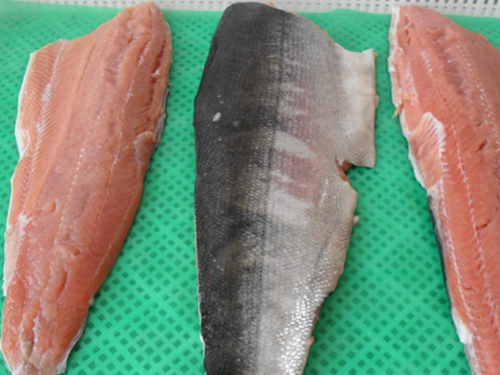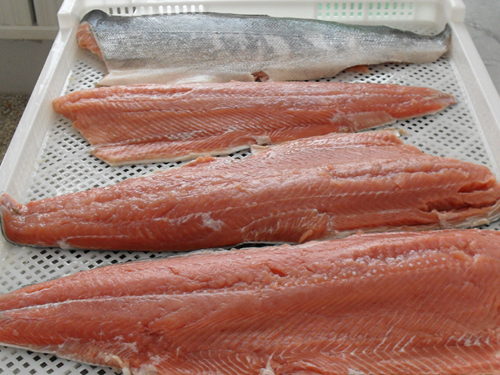- Skinless Salmon Portion
-
- Name: Skinless Salmon Portion
- Product ID:
- Place of Origin: Alaska
- Process: IQF
- MOQ: 20MT
- Package: 40lb/carton; 30lb/carton; 4x10lb/carton
- Payment Terms: L/C, T/T
- Delivery Terms: Fob Dalian, CIF


Prev: Salmon Portion with Skin Next: Skinless Salmon Portion IVP Packing
Skinless Salmon Portion Raw Material


Detailed Product Description
Salmon flesh is generally orange to red in colour, although there are some examples of white fleshed wild salmon. The natural colour of salmon results from carotenoid pigments, largely astaxanthin but also canthaxanthin, in the flesh. Wild salmon get these carotenoids from eating krill and other tiny shellfish. Because consumers have shown a reluctance to purchase white fleshed salmon, astaxanthin (E161j), and very minutely canthaxanthin (E161g), are added as artificial colorants to the feed of farmed salmon because prepared diets do not naturally contain these pigments. In most cases the astaxanthin is made chemically; alternatively it is extracted from shrimp flour. Another possibility is the use of dried red yeast, which provides the same pigment. However, synthetic mixtures are the least expensive option. Astaxanthin is a potent antioxidant that stimulates the development of healthy fish nervous systems and that enhances the fish's fertility and growth rate. Research has revealed canthaxanthin may have negative effects on the human eye, accumulating in the retina at high levels of consumption. Today the concentration of carotenoids (mainly canthaxanthin and astaxanthin) exceeds 8 mg/kg of flesh and all fish producers try to reach a level that represents a value of 16 on the "Roche Color Card", a colour card used to show how pink the fish will appear at specific doses. This scale is specific for measuring the pink colour due to astaxanthin and is not for the orange hue obtained with canthaxanthin. The development of processing and storage operations, which can be detrimental on canthaxanthin flesh concentration, has led to an increased quantity of pigments added to the diet to compensate for the degrading effects of the processing. In wild fish, carotenoid levels of up to 20–25 mg are present, but levels of canthaxanthin are, in contrast, minor.
Send Online Inuiry
- Related Products



 Original Image
Original Image

